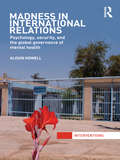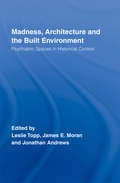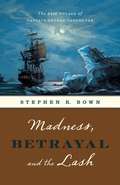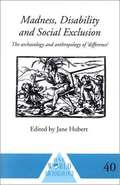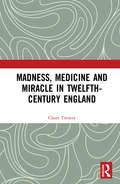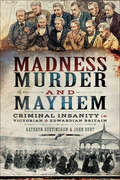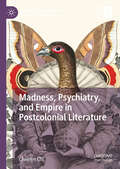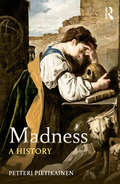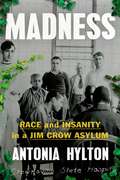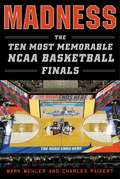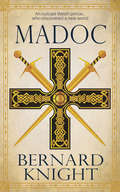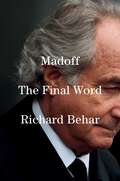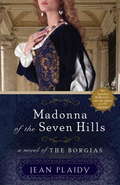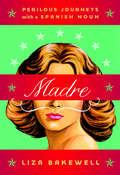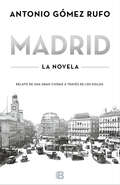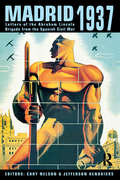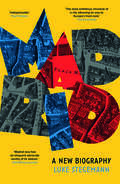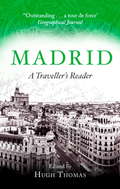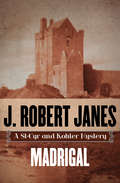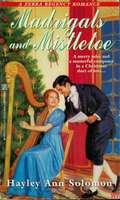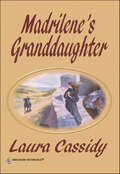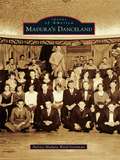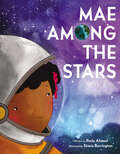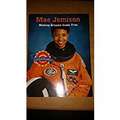- Table View
- List View
Madness in International Relations: Psychology, Security, and the Global Governance of Mental Health (Interventions)
by Alison HowellMadness in International Relations provides an important and innovative account of the role of psychology and psychiatry in global politics, showing how mental health governance has become a means of securing various populations, often with questionable effects. Through the analysis of three key case studies Howell illustrates how such therapeutic interventions can at times be coercive and sovereign, at other times disciplinary, and at still other times benevolent, though not benign. In each case a ‘diagnostic competition’ is traced, that is, a contestation over how best to diagnose and treat the population in question. The book examines the populations of Guantánamo Bay, post-conflict societies and western militaries, identifying how these diagnostic competitions ultimately rest on shared assumptions about the value of psychology and psychiatry in managing global security, about the value of achieving security through mental health governance, and ultimately about the medicalization of security. This work will be of great interest to all scholars of International relations, critical theory and security studies.
Madness, Architecture and the Built Environment: Psychiatric Spaces in Historical Context (Routledge Studies in the Social History of Medicine)
by Leslie Topp; James E. Moran; Jonathan AndrewsThis is the first volume of papers devoted to an examination of the relationship between mental health/illness and the construction and experience of space. This historical analysis with contributions from leading experts will enlighten and intrigue in equal measure. The first rigorous scholarly analysis of its kind in book form, it will be of particular interest to the history, psychiatry and architecture communities.
Madness, Betrayal and the Lash
by Stephen R. BownFrom 1792 to 1795, George Vancouver sailed the Pacific as the captain of his own expedition - and as an agent of imperial ambition. To map a place is to control it, and Britain had its eyes on America's Pacific coast. And map it Vancouver did. His voyage was one of history's greatest feats of maritime daring, discovery, and diplomacy, and his marine survey of Hawaii and the Pacific coast was at its time the most comprehensive ever undertaken. But just two years after returning to Britain, the 40-year-old Vancouver, hounded by critics, shamed by public humiliation at the fists of an aristocratic sailor he had flogged, and blacklisted because of a perceived failure to follow the Admiralty's directives, died in poverty, nearly forgotten. In this riveting and perceptive biography, historian Stephen Bown delves into the events that destroyed Vancouver's reputation and restores his position as one of the greatest explorers of the Age of Discovery.
Madness, Disability and Social Exclusion: The Archaeology and Anthropology of 'Difference'
by Jane HubertA unique work that brings together a broad range of specialist disciplines to create a new perspective on social and physical exclusion from society. Brings a much needed comparative approach to the subject of disability. Confinement, hermaphrodites, killing of disabled children, leprosy, deafness, and funerary rituals are explored.
Madness, Medicine and Miracle in Twelfth-Century England
by Claire TreneryThis book explores how madness was defined and diagnosed as a condition of the mind in the Middle Ages and what effects it was thought to have on the bodies, minds and souls of sufferers. Madness is examined through narratives of miraculous punishment and healing that were recorded at the shrines of saints. This study focuses on the twelfth century, which has been identified as a ‘Medieval Renaissance’: a time of cultural and intellectual change that saw, among other things, the circulation of new medical treatises that brought with them a wealth of new ideas about illness and health. With the expanding authority of the Roman Church and the tightening of papal control over canonisation procedures in this period, historians have claimed that there was a ‘rationalisation’ of the miraculous. In miracle records, illnesses were explained using newly-accessible humoral theories rather than attributed to divine and demonic forces, as they had been previously. The first book-length study of madness in medieval religion and medicine to be published since 1992, this book challenges these claims and reveals something of the limitations of the so-called ‘medicalisation’ of the miraculous. Throughout the twelfth century, demons continue to lurk in miracle records relating to one condition in particular: madness. Five case studies of miracle collections compiled between 1070 and 1220 reveal that hagiographical representations of madness were heavily influenced by the individual circumstances of their recording and yet were shaped as much by hagiographical patterns that had been developing throughout the twelfth century as they were by new medical and theological standards.
Madness, Murder and Mayhem: Criminal Insanity in Victorian and Edwardian Britain
by Kathryn Burtinshaw Dr. John BurtFollowing an assassination attempt on George III in 1800, new legislation significantly altered the way the criminally insane were treated by the judicial system in Britain. This book explores these changes and explains the rationale for purpose-built criminal lunatic asylums in the Victorian era.Specific case studies are used to illustrate and describe some of the earliest patients at Broadmoor Hospital the Criminal Lunatic Asylum for England and Wales and the Criminal Lunatic Department at Perth Prison in Scotland. Chapters examine the mental and social problems that led to crime alongside individuals considered to be weak-minded, imbeciles or idiots. Family murders are explored as well as individuals who killed for gain. An examination of psychiatric evidence is provided to illustrate how often an insanity defence was used in court and the outcome if the judge and jury did not believe these claims. Two cases are discussed where medical experts gave evidence that individuals were mentally irresponsible for their crimes but they were led to the gallows.Written by genealogists and historians, this book examines and identifies individuals who committed heinous crimes and researches the impact crime had on themselves, their families and their victims.
Madness, Psychiatry, and Empire in Postcolonial Literature (Palgrave Studies in Literature, Science and Medicine)
by Chienyn ChiMadness, Psychiatry, and Empire in Postcolonial Literature provides a comparatist interrogation of empire through archives of history, science, and literature. The book analyzes Aimé Césaire’s Discourse on Colonialism to shed light on Césaire’s critique of psychological and medical discourses of the colonized’s mind. The book argues that the discourse of psychiatry, psychology, and psychoanalysis has erased the context of power in global histories of empire. Through the book’s chapters, Chi analyzes Lu Xun’s “A Madman’s Diary,” Virginia Woolf’s Mrs. Dalloway, and Tsitsi Dangarembga’s Nervous Conditions to assert that the misapprehension of madness should not automatically be accepted as the history of an isolated Western culture but rather that of the history of imperialism—a globalizing process that silences alternative cultural conceptions of the mind, of madness, and of behavior, as well as different interpretations of madness.
Madness: A History
by Petteri PietikäinenMadness: A History is a thorough and accessible account of madness from antiquity to modern times, offering a large-scale yet nuanced picture of mental illness and its varieties in western civilization. The book opens by considering perceptions and experiences of madness starting in Biblical times, Ancient history and Hippocratic medicine to the Age of Enlightenment, before moving on to developments from the late 18th century to the late 20th century and the Cold War era. Petteri Pietikäinen looks at issues such as 18th century asylums, the rise of psychiatry, the history of diagnoses, the experiences of mental health patients, the emergence of neuroses, the impact of eugenics, the development of different treatments, and the late 20th century emergence of anti-psychiatry and the modern malaise of the worried well. The book examines the history of madness at the different levels of micro-, meso- and macro: the social and cultural forces shaping the medical and lay perspectives on madness, the invention and development of diagnoses as well as the theories and treatment methods by physicians, and the patient experiences inside and outside of the mental institution. Drawing extensively from primary records written by psychiatrists and accounts by mental health patients themselves, it also gives readers a thorough grounding in the secondary literature addressing the history of madness. An essential read for all students of the history of mental illness, medicine and society more broadly.
Madness: Race and Insanity in a Jim Crow Asylum
by Antonia HyltonIn the tradition of The Immortal Life of Henrietta Lacks, this New York Times bestseller is a page-turning account of one of the nation&’s last segregated asylums..."a book that left me breathless" (Clint Smith). For centuries, Black patients have been absent from our history books. Madness transports readers through the ninety-three-year history of Crownsville Hospital, one of the last segregated asylums with surviving records and a campus that still stands to this day in Anne Arundel County, Maryland. Antonia Hylton blends the intimate tales of patients and employees whose lives were shaped by Crownsville with a decade-worth of investigative research and archival documents. Madness chronicles the stories of Black families whose mental health suffered as they tried, and sometimes failed, to find safety and dignity. Hylton also grapples with her own family&’s experiences with mental illness, and the secrecy and shame that it reproduced for generations. As Crownsville Hospital grew from an antebellum-style work camp to a tiny city sitting on 1,500 acres, the institution became a microcosm of America&’s evolving battles over slavery, racial integration, and civil rights. Hylton traces the legacy of slavery to the treatment of Black people&’s bodies and minds in our current mental healthcare system. It is a captivating and heartbreaking meditation on how America decides who is sick or criminal, and who is worthy of our care or irredeemable.
Madness: The Ten Most Memorable NCAA Basketball Finals
by Mark Mehler Charles PaikertThe annual NCAA Basketball Tournament, which has become known as “March Madness” has emerged as a major sports event, matched only by the Super Bowl and the Olympics. In Madness, Mark Mehler and Charles Paikert tell the stories behind the ten most compelling and memorable championship games in tournament history, from North Carolina’s triple-overtime victory over Wilt Chamberlain’s Kansas Wildcats in 1957 to Duke’s heart stopping victory over underdog Butler in 2010. As a bonus, five more games that just missed the cut are also examined. Madness goes beyond the games to tell the the backstories of these classics, each entirely unique unto itself. For example, Jim Valvano taking his impossible dream of a national title and making it come true for the 1983 North Carolina State Wolfpack; Rollie Massimino turning spaghetti and clam sauce into inspiration for his underachieving 1985 Villanova team; and Magic Johnson and Larry Bird, breaking down in tears while taking a Broadway curtain call in front of a wildly-applauding audience who two hours earlier didn't know who these two guys were decades after their head-to-head matchup in 1979. Some of these stories also resonate far beyond the basketball court, including the 1966 triumph by the Texas Western Miners, which helped chisel away the college basketball color line and stamped their victory as "Glory Road." Over sixty years of college basketball history is brought to life in this must-have for all basketball fans.
Madoc
by Bernard KnightThe epic story of Prince Madoc, son of the ruler of North Wales, who after the death of his wife leaves behind the battles for power and prestige in his homeland and journeys into the unknown, sailing with a small group of companions across the Western Ocean.In this novel, acclaimed author Knight skilfully blends historical fact and the histories of medieval Britain and France with the story of a Welsh prince who, legend says, discovered the continent of North America.
Madoc
by Bernard KnightThe epic story of Prince Madoc, son of the ruler of North Wales, who after the death of his wife leaves behind the battles for power and prestige in his homeland and journeys into the unknown, sailing with a small group of companions across the Western Ocean.In this novel, acclaimed author Knight skilfully blends historical fact and the histories of medieval Britain and France with the story of a Welsh prince who, legend says, discovered the continent of North America.
Madoff: The Final Word
by Richard BeharRenowned investigative journalist Richard Behar delivers the definitive account of history&’s largest—and longest-running—financial fraud, &“the scale of the deception…beggars belief&” (New York Post).Some $68 billion evaporated during Bernie Madoff&’s epic confidence game. Two people were driven to suicide in the wake of the Ponzi Scheme&’s exposure. Others went to prison. But there has never been a satisfying accounting for how Bernie got away with so much, for so long. Until now. Richard Behar&’s relationship with Madoff began in 2011 with a simple email request from the conman. By the time Madoff died in 2021, he had sent Behar more than 300 emails and dozens of handwritten letters, participated in some fifty phone conversations, and sat for three in-person jailhouse interviews—a level of access provided to no other reporter. Behar also established relationships with hundreds of regulators, prosecutors, FBI agents, investors, Wall Street experts, ex-employees of Madoff&’s, family members, school classmates, and others. The result is the final word on the criminal behind history&’s most enduring fraud—and on those who believed him, covered for him, or locked him up. Behar illuminates not only the fraud&’s origins—decades earlier than Madoff claimed in his confession—but also the complicity of investors, Wall Street insiders, family members, and some of the largest banks in the US and Europe. Shocking, infuriating, riveting (and at times absurdly funny), Madoff shows us how Bernie ensnared thousands of investors. As Behar&’s dogged reporting over the last fifteen years makes clear, however, there aren&’t many innocents left standing by the end of this tale. Just about everyone involved is guilty, at a minimum, of humanity&’s most consistent weakness: greed.
Madonna of the Seven Hills (Lucrezia Borgia #1)
by Jean PlaidyThe most beautiful woman in Rome, Lucrezia Borgia, was born into a family-and a destiny-she could not hope to escape . . . Fifteenth-century Rome: The Borgia family is on the rise. Lucrezia#x19;s father, Pope Alexander VI, places his illegitimate daughter and her only brothers, Cesare, Giovanni, and Goffredo, in the jeweled splendor-and scandal-of his court. From the Pope#x19;s affairs with adolescent girls to Cesare#x19;s dangerous jealousy of anyone who inspires Lucrezia#x19;s affections to the ominous birth of a child conceived in secret, no Borgia can elude infamy. Young Lucrezia gradually accepts her fate as she comes to terms with the delicate nature of her relationships with her father and brothers. The unbreakable bond she shares with them both exhilarates and terrifies her as her innocence begins to fade. Soon she will understand that her family#x19;s love pales next to their quest for power and that she herself is the greatest tool in their political arsenal. From the inimitable pen of Jean Plaidy, this family#x19;s epic legend is replete with passion, intrigue, and murder-and it#x19;s only the beginning.
Madre: Perilous Journeys with a Spanish Noun
by Liza BakewellWhy is the word madre, "mother," so complicated in Spanish--especially in Mexico? Leaping off the page with energy, insight, and attitude, Liza Bakewell's exploration of language is anything but "just semantics." Why does me vale madre mean worthless, while !qué padre! means fabulous, she asks? And why do one hundred madres disappear when one padre enters the room, converting the group from madres to padres? Thus begins a journey through Mexican culture in all its color: weddings, dinner parties, an artist's studio, heart-stopping taxi rides, angry journalists, corrupt politicians, Blessed Virgins, and mothers both sacred and profane. Along the way, a reader discovers not only an invaluable lexicon of Mexican slang (to be used with caution or not at all) but also thought-provoking reflections on the evolution of language; its winding path through culture, religion, and politics; and, not least, what it means--and what it threatens--to be a creative female, a madre.
Madrid (Ed. actualizada)
by Antonio Gómez RufoEdición actualizada de la gran novela de Antonio Gómez Rufo sobre Madrid, un libro de referencia para todos los que aman esta ciudad. Esta es la gran novela de Madrid. Su historia, su épica, su vida cotidiana. Siendo de todos, Madrid nunca ha sido de nadie. De ahí su grandeza y su sencillez, su orgullo y su humildad, su carácter revolucionario y su dignidad. A través de tres apasionantes sagas familiares, Antonio Gómez Rufo traza el emocionante relato literario de Madrid, desde una mañana de 1565 en que los jóvenes Juan Posada, Alonso Vázquez y Guzmán de Tarazona atraviesan por primera vez la antigua Puerta del Sol dispuestos a probar suerte en la Villa y Corte, hasta enero de 2021, cuando después de un año marcado por la pandemia, un gran manto de nieve cubrió una de las ciudades más hermosas del mundo. Las personas pasan, los relatos acaban y los ríos se despeñan y apaciguan antes de ahogarse en el mar; pero las ciudades permanecen y su historia no se detiene en su lento viaje hacia la eternidad.
Madrid 1937: Letters of the Abraham Lincoln Brigade From the Spanish Civil War
by Cary Nelson Jefferson HendricksFirst Published in 1996. Routledge is an imprint of Taylor & Francis, an informa company.
Madrid: A New Biography
by Luke StegemannThe miraculous story of Madrid—how a village became a great world city For centuries Madrid was an insignificant settlement on the central Iberian plateau. Under its Muslim rulers the town was fortified and enlarged, but even after the Reconquista it remained secondary to nearby Toledo. But Madrid’s fortunes dramatically shifted in the sixteenth century, becoming the centre of a vast global empire. Luke Stegemann tells the surprising story of Madrid’s flourishing, and its outsize influence across the world. From Cervantes and Quevedo to Velázquez and Goya, Spain’s capital has been home to some of Europe’s most influential artists and thinkers. It formed a vital link between Europe and the Americas and became a cauldron of political dissent—not least during the Spanish Civil War, when the city was on the frontline in the fight against fascism. Stegemann places Madrid and its people in global context, showing how the city—fast overtaking Barcelona as a centre of international finance and cultural tourism—has become a melting pot at the heart of Europe and the wider Hispanic world.
Madrid: A Traveller's Reader (Traveller's Reader)
by Hugh ThomasThe charm of Madrid is elusive, but for those who know how to find it, Madrid has magic. Its magic can be found in the shadow cast over the present by the past. In this Traveller's Reader, a city that was once the seat of power for perhaps the most ambitious political enterprise the western world had seen since the fall of Rome, the Spanish Empire, is brought to life in vivid diaries, letters, memoirs and histories.The Earl of Clarendon describes seventeenth-century bullfights; Salvador Dali plays a surrealist joke on a snooty barman at the Ritz; Rubens visits the Alcázar; Manet is at the Prado; generals and anarchists meet in the Puerta del Sol. The many stories included here evoke for today's tourist the dramas and personalities of a city's past, by drawing on the eyewitness accounts and commentaries of visitors and residents of earlier centuries. Hugh Thomas has chosen these and other vivid snapshots of Madrid's history from diaries, letters, memoirs and novels across five centuries to delight and fascinate the armchair and prospective traveller alike.
Madrigal (The St-Cyr and Kohler Mysteries #10)
by J. Robert JanesIn Nazi-occupied France, a French-German detective team must solve a murder in Avignon&’s Papal Palace—&“Plenty of atmosphere and a great setting&” (The Globe and Mail). Six hundred years before the Germans conquered Paris, the pope came to Avignon to rule the Roman Church from afar. In January 1943, Jean-Louis St-Cyr and Hermann Kohler visit the former Papal Palace—not as tourists, but as detectives. Where once the pope spoke to God, a woman has had her throat cut. Her corpse seems to have appeared from out of the past. Despite the strictures of wartime rationing, she died in finery, costumed in the ermine and silk of a Renaissance courtier. She appears to have been killed with a scythe, pulled across her neck in one swift stroke, like a shepherd slaughtering a sheep. Wartime Avignon is a small city, steeped in the jealousy that occupation encourages. As St-Cyr and Kohler dig into the city&’s past, they find motives for murder that predate the Nazis by centuries.
Madrigals And Mistletoe
by Cassie Ryan Hayley Ann SolomonA Song Of Love... Seraphina Camfrey, newest darling of the ton, is angelic in both name and face. Alas, the same can scarcely be said for her singing. And now she fears her off-key notes have sentenced her to yet another fussy old tutor. But Captain Argyll, though arrogant, proves irresistible! So the scampish Seraphina cares nothing for plans to match her with a duke at a country Christmas. Starry-eyed amid the snow and sugar plums, she hears only her heartstrings--strummed by her handsome music master. ...In A Season Of Joy Frederick Argyll is all set to fund his musical composition by teaching. No doubt his pupil will be some dreary wallflower. But Seraphina's hair flames as bright as the yule log and her spirit crackles as cheerily. Can Frederick mold her into the star of the Christmas pageant, and--despite a medley of misunderstandings--accompany her in holiday harmonies of love?
Madrilene's Granddaughter
by Laura CassidyThe beauty within...Hal Latimar could see it in Rachel's shy, quiet smile and patient stance. At a raucous celebration of wedded bliss, the secretive young woman was upstaged by her beautiful cousin. But Hal knew that outward beauty was sometimes hidden and deceptive. When Queen Elizabeth's plans brought them to Court, he found his sights firmly set on Rachel, whose sweetness knew no bounds. The more time he spent with her the more his appreciation gave way to desire. Though he was soon to learn that Rachel had a carefully guarded secret, which, once known, would jeopardize her presence at Court and the tender feelings growing between them....
Madura's Danceland (Images of America)
by Patrice Madura Ward-SteinmanDanceland! For hundreds of thousands of couples from all around the Calumet region of Northwest Indiana and Chicago's East Side, the name alone conjures up memories of dancing and romancing to thousands of live big bands. Opening night in October 1929 drew over 2,000 people to the beautiful ballroom with the famous maplewood dance floor. It continued to thrive with live music four nights a week and 12 months a year throughout the Big Band Era, despite the Great Depression and World War II, and into the rock 'n roll era, until it burned to the ground on Sunday morning, July 23, 1967. Almost everyone's marriage in the region began with a dance at Madura's Danceland. In the 38 years Danceland was open, it had only two owners and managers, Michael (Mike) Madura Sr. and Michael (Mick) J. Madura Jr., father and son. It remained a family business for all those years, with three generations of the Madura family having worked there in many capacities.
Mae Among the Stars
by Roda AhmedA beautiful picture book for sharing and marking special occasions such as graduation, inspired by the life of the first African American woman to travel in space, Mae Jemison. An Amazon Best Book of the Month!A great classroom and bedtime read-aloud, Mae Among the Stars is the perfect book for young readers who have big dreams and even bigger hearts.When Little Mae was a child, she dreamed of dancing in space. She imagined herself surrounded by billions of stars, floating, gliding, and discovering.She wanted to be an astronaut.Her mom told her, "If you believe it, and work hard for it, anything is possible.”Little Mae’s curiosity, intelligence, and determination, matched with her parents' encouraging words, paved the way for her incredible success at NASA as the first African American woman to travel in space.This book will inspire other young girls to reach for the stars, to aspire for the impossible, and to persist with childlike imagination.
Mae Jemison Making Dreams Come True (Houghton Mifflin Reading Leveled Readers)
by C. M. Thorsen"The space shuttle Endeavour launched from Kennedy Space Center on September 12, 1992. This was the first time astronauts from the United States and Japan worked together. But it was important for another reason as well. On board was a special woman, Dr. Mae Carol Jemison. She was the mission's science specialist and was also the first African American woman to voyage into space. This book is a biography of Dr. Mae Carol Jemison."
